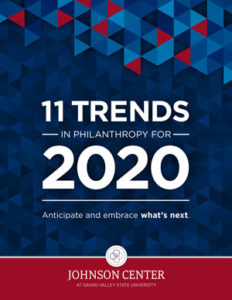Philanthropy Will Be On the Front Lines of Climate Change


Behrens and Martin explore further in this piece from our 11 Trends in Philanthropy for 2020 report.
 As the effects of climate change continue to become more powerful, nonprofit organizations and the funders who support them will play critical roles on the front lines of responding to and mitigating climate disasters. Most of this work falls into four key categories:
As the effects of climate change continue to become more powerful, nonprofit organizations and the funders who support them will play critical roles on the front lines of responding to and mitigating climate disasters. Most of this work falls into four key categories:
Extreme weather attributed to climate change has led to increased demand for emergency services and crisis relief. Fires in California and Australia, record flooding in the upper Midwest and Indonesia, and tornadoes and hurricanes across the globe fuel demand for food, water, housing, and emergency medical care — all typically provided by nonprofits.
“Extreme weather attributed to climate change has led to increased demand for emergency services and crisis relief.”
The U.S. Global Change Research Program (2014), for example, notes that unprecedented multi-month extreme heat waves have been occurring, often contributing to droughts. At the other end of the spectrum, heavy rain in the Midwest and Northeast has led to flooding. During the past year, the Center for Disaster Philanthropy gave $10.9 million in grants to 65 U.S. and international organizations to address needs ranging from emergency shelter to debris removal and mental health services.
Environmental and climate-related issues are being overlaid on issues that foundations and nonprofits have typically addressed. For funders and nonprofits concerned with social justice, for example, environmental justice is becoming a more important issue, as low-income communities have the fewest resources and poorest infrastructure, putting them at the greatest risk from climate change. The Kresge Foundation, as one example, has linked climate resilience with its focus on urban opportunities (Dorothy A. Johnson Center for Philanthropy, 2019).
For those in the philanthropic sector focused on basic needs domestically and internationally, scarcity is likely to increase as rising temperatures lead to crop failures. Some experts are predicting that Sudan, for example, will be uninhabitable in 40 years due to drought and crop failures (Britton, 2016). Nonprofits will be at the forefront in providing hunger relief, running refugee camps for displaced populations, and addressing the physical and mental health consequences.
“[E]nvironmental justice is becoming a more important issue, as low-income communities have the fewest resources and poorest infrastructure, putting them at the greatest risk from climate change.”
Those organizations focused on health will see increasing demand for both old and new health services. The Medical Society Consortium on Climate and Health has summarized the health threats of climate change, concluding that, “We are sounding the alarm that climate change poses a risk to the health of every American” (Sarfaty, Gould, & Maibach, 2017, p. 25). The spread of tropical diseases to new regions, poorer air quality, and contaminated food are some examples of the widespread ways in which changes in climate impact health.
Nonprofits (and social enterprises) are also at the forefront of developing proactive strategies for mitigating or even reversing the effects of climate change. The United Nations Momentum for Change climate solutions awards, for instance, recognize dynamic nonprofits that are bringing unique solutions to the table. Recent winners include:
As nonprofits and funders pursue these burgeoning opportunities, evaluators in philanthropy have also begun developing innovative approaches to evaluation that incorporate environmental sustainability into the process (Patton, 2020; Parsons, Dhillon, & Keene, 2019), providing new tools for the sector.
The philanthropic sector is at the forefront of advocacy efforts to combat climate change. The Environmental Grantmakers Association (2017) reports that the most-funded strategies in 2015 (the most recent data) among their members were related to advocacy (35% of grants), with both energy and climate reaching record highs that year ($226 million and $142 million respectively). We Are Still In, funded and coordinated by a multi-sector coalition that includes municipalities, businesses, nonprofits, and others in all 50 states, is dedicated to meeting the goals set in the Paris Climate Accord.
Research supports the important role that nonprofits can play in climate advocacy. For example, Bies, Lee, Lindsey, Stoutenborough, and Vedlitz (2013) researched the role of nonprofits in influencing citizens’ orientation toward climate change as a problem:
… [I]t appears that it is the sense of legitimacy and trust that citizens have for environmental organizations and the information they provide that is exerting the greatest influence. This is a very important finding that should further encourage environmental organizations as they produce and disseminate relevant information, and, when doing so, seek to maintain their respected positions of legitimacy and trust. (p. 21)
Climate change is often referred to as the most pressing issue of our time. As is often the case, the philanthropic sector will be called upon to take a leadership role in mitigating and preventing its impacts.


Bies, A. L., Lee, D. G., Lindsey, C., Stoutenborough, J. W., & Vedlitz, A. (2013). Citizens, nonprofits and climate change policy. Nonprofit Policy Forum, 4(1), 5–28. Retrieved from https://doi.org/10.1515/npf-2012-0001
Britton, B. (2016, December 8). Climate change could render Sudan ‘uninhabitable’. CNN. Retrieved from https://www.cnn.com/2016/12/07/africa/sudan-climate-change
Canfield, F. C., Henderson, M., Li, A., & Niska, L. (2017). A summary from the Environmental Grantmakers Association’s Tracking the Field: Volume 6: Analyzing trends in environmental grantmaking. New York, NY: Environmental Grantmakers Association. Retrieved from https://ega.org/sites/default/files/page/attachment/EGA%20Tracking%20the%20Field%20Volume%206%20Executive%20Summary.pdf
Center for Disaster Philanthropy. (2019, December 30). Center for Disaster Philanthropy grants total $10.9 million in support of disaster recovery in the US and abroad in 2019 [Press release]. Retrieved from https://disasterphilanthropy.org/press-release/center-for-disaster-philanthropy-grants-total-10-9-million-in-support-of-disaster-recovery-in-the-us-and-abroad-in-2019
Dorothy A. Johnson Center for Philanthropy. (2019, May). Grantmaking That Advances Equity: A teaching case. Retrieved from https://johnsoncenter.org/wp-content/uploads/2019/05/Grantmaking-that-Advances-Equity-WEB.pdf
Parsons, B., Dhillon, L., & Keene, M., editors. (2019). Visionary Evaluation for a Sustainable Future. Charlotte, NC: Information Age Publishing.
Patton, M. Q. (2019). Blue marble evaluation. New York, NY: Guilford Press.
Sarfaty, M., Gould, R. J., & Maibach, E. W. (2017, March 15). Medical alert! Climate change is harming our health. Fairfax, VA: Medical Society Consortium on Climate & Health. Retrieved from https://medsocietiesforclimatehealth.org/reports/medical-alert
Tugend, A. (2018, September 21). On the attack against climate change. The New York Times. Retrieved from https://www.nytimes.com/2018/09/21/climate/climate-change-groups.html
U.S. Global Change Research Program. (2014). 2014 National climate assessment. Washington, DC: Author. Retrieved from https://nca2014.globalchange.gov/highlights/report-findings/extreme-weather